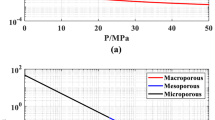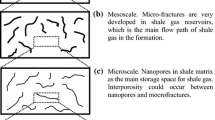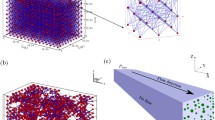Abstract
Shale reservoirs are characterized by very low permeability in the scale of nano-Darcy. This is due to the nanometer scale of pores and throats in shale reservoirs, which causes a difference in flow behavior from conventional reservoirs. Slip flow is considered to be one of the main flow regimes affecting the flow behavior in shale gas reservoirs and has been widely studied in the literature. However, the important mechanism of gas desorption or adsorption that happens in shale reservoirs has not been investigated thoroughly in the literature. This paper aims to study slip flow together with gas desorption in shale gas reservoirs using pore network modeling. To do so, the compressible Stokes equation with proper boundary conditions was applied to model gas flow in a pore network that properly represents the pore size distribution of typical shale reservoirs. A pore network model was created using the digitized image of a thin section of a Berea sandstone and scaled down to represent the pore size range of shale reservoirs. Based on the size of pores in the network and the pore pressure applied, the Knudsen number which controls the flow regimes was within the slip flow regime range. Compressible Stokes equation with proper boundary conditions at the pore’s walls was applied to model the gas flow. The desorption mechanism was also included through a boundary condition by deriving a velocity term using Langmuir-type isotherm. It was observed that when the slip flow was activated together with desorption in the model, their contributions were not summative. That, is the slippage effect limited the desorption mechanism through a reduction of pressure drop. Eagle Ford and Barnett shale samples were investigated in this study when the measured adsorption isotherm data from the literature were used. Barnett sample showed larger contribution of gas desorption toward gas recovery as compared to Eagle Ford sample. This paper has produced a pore network model to further understand the gas desorption and the slip flow effects in recovery of shale gas reservoirs.













Similar content being viewed by others
Abbreviations
- N :
-
Coordination normal to the wall
- \( L_{\text{s}} \) :
-
Slip length (m)
- \( u_{\text{T}} \) :
-
Thermal motion velocity
- \( u_{\text{s}} \) :
-
Slip velocity (m/s)
- u w :
-
Wall velocity (m/s)
- u d :
-
Velocity term for desorption boundary condition
- C 1 :
-
First-order slip coefficient
- u :
-
Fluid velocity
- K :
-
Permeability (m2)
- M :
-
Gas molecular mass (kg/mol)
- L :
-
Length (m)
- p :
-
Pore pressure (Pa)
- D :
-
Diffusion coefficient
- D n :
-
Knudsen diffusion coefficient
- d p :
-
Pore diameter
- A :
-
Cross-sectional area (m2)
- T :
-
Temperature (K)
- vl :
-
Langmuir volume (m3/kg)
- \( R = 8.31445 \times 10^{3} \) :
-
Gas constant (g/m2/s2/mol/K)
- λ :
-
Mean free path of flowing gas
- μ :
-
Gas viscosity (Pa s)
- σ v :
-
Tangential accommodation coefficient
- ρ :
-
Gas density (kg/m3)
- ρ r :
-
Rock density (kg/m3)
- s :
-
Slip
- K n :
-
Knudsen number
- \( {\text{Re}} \) :
-
Reynold number
References
Ahmadi, M.A., Shadizadeh, S.R.: Experimental investigation of a natural surfactant adsorption on shale-sandstone reservoir rocks: static and dynamic conditions. Fuel 159, 15–26 (2015)
Batchelor, G.K.: An Introduction to Fluid Dynamics. Cambridge University Press, Cambridge (2000)
Brown, G.P., DiNardo, A., Cheng, G.K., Sherwood, T.K.: The flow of gases in pipes at low pressures. J. Appl. Phys. 17(10), 802–813 (1946)
Chen, L., Zhang, L., Kang, Q., Viswanathan, H.S., Yao, J., Tao, W.: Nanoscale simulation of shale transport properties using the lattice Boltzmann method: permeability and diffusivity. Sci. Rep. 5, 8089 (2015)
Cipolla, C.L., Lolon, E., Erdle, J., Tathed, V.: Modeling well performance in shale-gas reservoirs. In: SPE/EAGE Reservoir Characterization and Simulation Conference (2009)
Civan, F.: Effective correlation of apparent gas permeability in tight porous media. Transp. Porous Media 82(2), 375–384 (2010)
Crain, E.: Crain’s Petrophysical Handbook. Spectrum 2000 Mindware Limited, Alberta (2002)
Curtis, J.B.: Fractured shale-gas systems. AAPG Bull. 86(11), 1921–1938 (2002)
Darabi, H., Ettehad, A., Javadpour, F., Sepehrnoori, K.: Gas flow in ultra-tight shale strata. J. Fluid Mech. 710, 641–658 (2012)
Etminan, S.R., Javadpour, F., Maini, B.B., Chen, Z.: Measurement of gas storage processes in shale and of the molecular diffusion coefficient in kerogen. Int. J. Coal Geol. 123, 10–19 (2014)
Fathi, E., Akkutlu, I.Y.: Nonlinear sorption kinetics and surface diffusion effects on gas transport in low-permeability formations. In: SPE Annual Technical Conference and Exhibition 2009. Society of Petroleum Engineers (2009)
Fathi, E., Akkutlu, I.Y.: Lattice Boltzmann method for simulation of shale gas transport in kerogen. SPE J. 18(01), 27–37 (2012)
Fatt, I.: The network model of porous media. Pet. Trans. AIME 207, 144–181 (1956)
Fink, R., Krooss, B.M., Gensterblum, Y., Amann-Hildenbrand, A.: Apparent permeability of gas shales—superposition of fluid-dynamic and poro-elastic effects. Fuel 199, 532–550 (2017)
Freeman, C., Moridis, G., Blasingame, T.: A numerical study of microscale flow behavior in tight gas and shale gas reservoir systems. Transp. Porous Media 90(1), 253 (2011)
Gad-el-Hak, M.: The fluid mechanics of microdevices—the Freeman scholar lecture. J. Fluids Eng. 121(1), 5–33 (1999)
Heller, R., Zoback, M.: Adsorption of methane and carbon dioxide on gas shale and pure mineral samples. J. Unconv. Oil Gas Resour. 8, 14–24 (2014)
Hornbrook, J., Castanier, L., Pettit, P.: Observation of foam/oil interactions in a new, high-resolution micromodel. In: SPE Annual Technical Conference and Exhibition 1991. Society of Petroleum Engineers (1991)
Huang, X., Bandilla, K.W., Celia, M.A.: Multi-physics pore-network modeling of two-phase shale matrix flows. Transp. Porous Media 111(1), 123–141 (2016)
Javadpour, F.: Nanopores and apparent permeability of gas flow in mudrocks (shales and siltstone). J. Can. Pet. Technol. 48(08), 16–21 (2009)
Kang, S.M., Fathi, E., Ambrose, R.J., Akkutlu, I.Y., Sigal, R.F.: Carbon dioxide storage capacity of organic-rich shales. SPE J. 16(04), 842–855 (2011)
Karniadakis, G., Beskok, A., Aluru, N.: Microflows and Nanoflows: Fundamentals and Simulation, vol. 29. Springer, Berlin (2006)
Keller, A.A., Blunt, M.J., Roberts, A.P.V.: Micromodel observation of the role of oil layers in three-phase flow. Transp. Porous Media 26(3), 277–297 (1997)
Kim, S., Karrila, S.J.: Microhydrodynamics: Principles and Selected Applications. Courier Corporation, North Chelmsford (2013)
Klinkenberg, L.: The permeability of porous media to liquids and gases. In: Drilling and Production Practice, New York, 1 January 1941 (1941)
Langmuir, I.: The constitution and fundamental properties of solids and liquids. Part I. Solids. J. Am. Chem. Soc. 38(11), 2221–2295 (1916)
Li, J., Yu, T., Liang, X., Zhang, P., Chen, C., Zhang, J.: Insights on the gas permeability change in porous shale. Adv. Geo-Energy Res. 1, 63–67 (2017)
Lin, D., Wang, J., Yuan, B., Shen, Y.: Review on gas flow and recovery in unconventional porous rocks. Adv. Geo-Energy Res. 1(1), 39–53 (2017)
Liu, H.-H., Georgi, D., Chen, J.: Correction of source-rock permeability measurements owing to slip flow and Knudsen diffusion: a method and its evaluation. Pet. Sci. 15(1), 116–125 (2018)
Mehmani, A., Prodanović, M., Javadpour, F.: Multiscale, multiphysics network modeling of shale matrix gas flows. Transp. Porous Media 99(2), 377–390 (2013)
Moghadam, A.A., Chalaturnyk, R.: Expansion of the Klinkenberg’s slippage equation to low permeability porous media. Int. J. Coal Geol. 123, 2–9 (2014)
Moghaddam, R.N., Foroozesh, J.: Stress dependent capillary dominated flow in matrix around hydraulic fractures in shale reservoirs and its impact on well deliverability. In: SPE Symposium: Production Enhancement and Cost Optimisation 2017. Society of Petroleum Engineers (2017)
Moghaddam, R.N., Jamiolahmady, M.: Slip flow in porous media. Fuel 173, 298–310 (2016)
Moghaddam, R.N., Aghabozorgi, S., Foroozesh, J.: Numerical simulation of gas production from tight, ultratight and shale gas reservoirs: flow regimes and geomechanical effects. In: EUROPEC 2015. Society of Petroleum Engineers (2015)
Moridis, G.J., Blasingame, T.A., Freeman, C.M.: Analysis of mechanisms of flow in fractured tight-gas and shale-gas reservoirs. In: SPE Latin American and Caribbean Petroleum Engineering Conference 2010. Society of Petroleum Engineers (2010)
NIST: NIST chemistry webbook. https://webbook.nist.gov/chemistry/ (2018). Accessed 5 Aug 2018
Pang, Y., Soliman, M.Y., Deng, H., Emadi, H.: Analysis of effective porosity and effective permeability in shale-gas reservoirs with consideration of gas adsorption and stress effects. SPE J. 33, 1605 (2017)
Rouquerol, J., Avnir, D., Fairbridge, C., Everett, D., Haynes, J., Pernicone, N., Ramsay, J., Sing, K., Unger, K.: Recommendations for the characterization of porous solids (Technical Report). Pure Appl. Chem. 66(8), 1739–1758 (1994)
Sakhaee-Pour, A., Bryant, S.: Gas permeability of shale. SPE Reserv. Eval. Eng. 15(04), 401–409 (2012)
Shabro, V., Torres-Verdín, C., Javadpour, F., Sepehrnoori, K.: Finite-difference approximation for fluid-flow simulation and calculation of permeability in porous media. Transp. Porous Media 94(3), 775–793 (2012)
Sheng, M., Li, G., Huang, Z., Tian, S.: Shale gas transient flow model with effects of surface diffusion. Acta Petrol. Sin. 35(2), 347–352 (2014)
Sheng, M., Li, G., Huang, Z., Tian, S., Shah, S., Geng, L.: Pore-scale modeling and analysis of surface diffusion effects on shale-gas flow in Kerogen pores. J. Nat. Gas Sci. Eng. 27, 979–985 (2015)
Singh, H., Javadpour, F.: Nonempirical apparent permeability of shale. In: Unconventional Resources Technology Conference (URTEC) (2013)
Sondergeld, C.H., Newsham, K.E., Comisky, J.T., Rice, M.C., Rai, C.S.: Petrophysical considerations in evaluating and producing shale gas resources. In: SPE Unconventional Gas Conference 2010. Society of Petroleum Engineers (2010)
Song, W., Yao, J., Ma, J., Couples, G., Li, Y.: Assessing relative contributions of transport mechanisms and real gas properties to gas flow in nanoscale organic pores in shales by pore network modelling. Int. J. Heat Mass Transf. 113, 524–537 (2017)
Strapoc, D., Mastalerz, M., Schimmelmann, A., Drobniak, A., Hasenmueller, N.R.: Geochemical constraints on the origin and volume of gas in the New Albany Shale (Devonian–Mississippian), eastern Illinois Basin. AAPG Bull. 94(11), 1713–1740 (2010)
Sun, H., Yao, J., Cao, Y.-C., Fan, D.-Y., Zhang, L.: Characterization of gas transport behaviors in shale gas and tight gas reservoirs by digital rock analysis. Int. J. Heat Mass Transf. 104, 227–239 (2017)
Sutton, R.P., Cox, S.A., Barree, R.D.: Shale gas plays: a performance perspective. In: Tight Gas Completions Conference 2010. Society of Petroleum Engineers (2010)
Valkó, P.P., Lee, W.J.: A better way to forecast production from unconventional gas wells. In: SPE Annual Technical Conference and Exhibition 2010. Society of Petroleum Engineers (2010)
Villazon, M., German, G., Sigal, R.F., Civan, F., Devegowda, D.: Parametric investigation of shale gas production considering nano-scale pore size distribution, formation factor, and non-Darcy flow mechanisms. In: SPE annual technical conference and exhibition 2011. Society of Petroleum Engineers (2011)
Wang, Z., Li, Y., Guo, P., Meng, W.: Analyzing the adaption of different adsorption models for describing the shale gas adsorption law. Chem. Eng. Technol. 39(10), 1921–1932 (2016)
Wu, K., Li, X., Wang, C., Yu, W., Chen, Z.: Model for surface diffusion of adsorbed gas in nanopores of shale gas reservoirs. Ind. Eng. Chem. Res. 54(12), 3225–3236 (2015)
Xianggang, D., Zhiming, H., Shusheng, G., Rui, S., Huaxun, L., Chang, J., Lin, W.: Shale high pressure isothermal adsorption curve and the production dynamic experiments of gas well. Petrol. Explor. Dev. 45(1), 127–135 (2018)
Yang, F., Ning, Z., Zhang, R., Zhao, H., Krooss, B.M.: Investigations on the methane sorption capacity of marine shales from Sichuan Basin, China. Int. J. Coal Geol. 146, 104–117 (2015)
Zhang, W.-M., Meng, G., Wei, X.-Y., Peng, Z.-K.: Slip flow and heat transfer in microbearings with fractal surface topographies. Int. J. Heat Mass Transf. 55(23–24), 7223–7233 (2012a)
Zhang, W.-M., Meng, G., Wei, X.: A review on slip models for gas microflows. Microfluid. Nanofluid. 13(6), 845–882 (2012b)
Acknowledgements
This research has been carried out in Petroleum Engineering Department at Universiti Teknologi PETRONAS (UTP). UTP has fully supported this research which is greatly acknowledged.
Author information
Authors and Affiliations
Corresponding author
Rights and permissions
About this article
Cite this article
Foroozesh, J., Abdalla, A.I.M. & Zhang, Z. Pore Network Modeling of Shale Gas Reservoirs: Gas Desorption and Slip Flow Effects. Transp Porous Med 126, 633–653 (2019). https://doi.org/10.1007/s11242-018-1147-6
Received:
Accepted:
Published:
Issue Date:
DOI: https://doi.org/10.1007/s11242-018-1147-6




